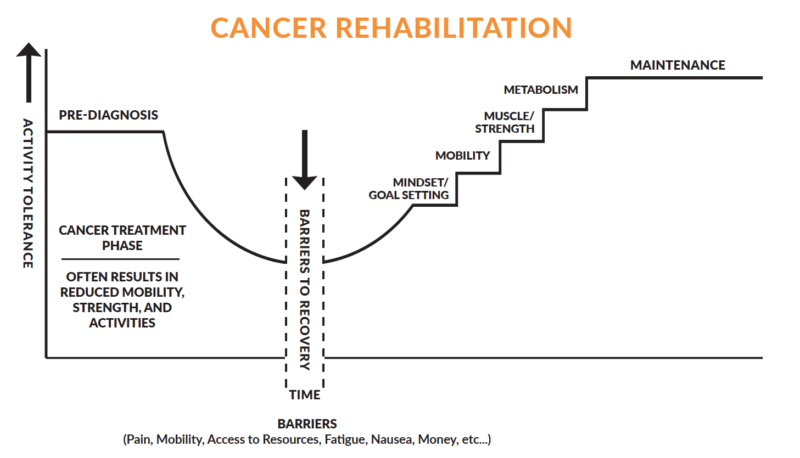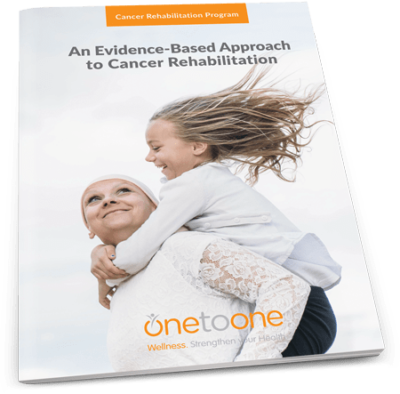Cancer Rehabilitation Program in Halifax, NS

Introduction
Cancer is a disease that we all fear. Treatments can leave you exhausted, in pain, feeling sick and weak. One to One Wellness has developed this program to empower you throughout this journey. Education, exercise, and mobility training are proven tools to enable you to regain control over your health. This safe method not only helps you combat this disease and it’s treatment side effects, but it gives you more empowerment over your life from diagnosis right through to post-treatment.
What is Cancer Rehabilitation?
After cancer diagnosis, there are many aspects to health that come into consideration as treatments take a toll on our physical, psychological and social well-being. This program is designed to provide you with a safe method of maintaining or regaining your strength and mobility to help maintain your quality of life throughout this entire journey.
Why Cancer Rehabilitation?
After cancer treatment, continuing to work on your mobility and strength is very important. The long term and late effects of cancer treatments can be minimized and potentially prevented through a regular exercise that includes two bone and muscle strength training sessions per week and at least 22 minutes of moderate intensity exercise per day.
What Does the Evidence Show?
- Increase Quality of Life
- Improve Muscular Strength
- Reduce Pain and Fatigue
- Decrease Recurrence Rates & Risk of Second Primary Cancers and Death by 50%
- Decrease Cardiovascular Risks
- Decrease Estrogen production in female breast cancer survivors
- Decrease Estrogen side-effects in prostate cancer survivors
What are the components of the program?
Mindset and Education
Pain is one of the main barriers to people participating in an exercise program. Our therapists have helped thousands of Nova Scotians better understand their pain through Pain Neuroscience Education and can help you better understand the following:
- Active Cancer Pain vs. Pain from Active Cancer Treatments
- Medication and Treatment side effects that include
- Numbness/tingling, joint and muscle pain
- Movements to help decrease pain sensitivity
- Long term and Late side effects of treatments
- How to pace your activities to better manage fatigue and pain
- Why your pain may not be going away
Part of the treatment plan will be to set individualized goals using the SMART principle: Specific, Measurable, Attainable, Realistic, and Time Frame. This helps empower and motivate you in managing your health.
Mobility
Your physiotherapist may ask you to do some exercises at home, in addition to exercises performed in our office, to maintain or continue to improve your mobility throughout the program. These at home and in offce exercises may include:
- Graded Motor Imagery
- Active-Assisted Range of Motion
- Neurodynamic Mobilizations
- Passive Range of Motion
- Gentle Joint Mobilizations
- Somatic and Body Awareness Exercises
- Self Neurodynamic Mobilizations
- Functional Tasks (E.g., Sit to Stand)
- Walking
Muscle
After your initial assessment, your physiotherapist will slowly introduce you to our semi-private training room. We use a slow-motion strength training protocol that allows you to strengthen within and move beyond your current limits. This helps reduce the amount of force on your joints and makes our workouts very efficient. Our equipment is designed to be adjusted for every person’s size and available range of motion.
Metabolism
Patients can easily become fatigued, nauseated, weak and ill, making activities a little more difficult to do. This all happens due to the change in metabolic processes in our body (Breaking things down and building things back up).
Our Therapists will help you manage your energy and fatigue through Pacing and Graded Exposure techniques. This will ensure you are doing this safely and still have enough energy to complete your daily tasks.
Our therapists track your progress every session that you attend. The questionnaires you fill out throughout the program are to ensure your goals are being met and provide consistent communication with your family physician. Your physiotherapist may ask you to keep track of your activity throughout the day. This is to see where your current activity levels are and to compare them to the end of the program.

Find out if the One To One Cancer Rehabilitation Program is for you with a FREE Screening.
This program has been designed based on the Ontario Cancer Care Guidelines for Exercise which states the following:
“People living with cancer can safely engage in moderate amounts of exercise while on active treatments or post completion of treatments”
“Exercise provides benefits in quality of life and muscular and aerobic fitness and does not cause harm”
“The potential benefits of exercise far exceed the potential associated risk“
WHAT ARE THE COMPONENTS OF THE PROGRAM?
WEEK 1
One hour Initial Assessment
One 30-Minute Session: Goal Setting and Pain Education
WEEK 2
One 30-Minute Session: Intro to Mobility and Pacing
One 30-minute session: Mobility Review & Intro to Strength
WEEK 3
Two 30 Minute Sessions: Mobility and Strength
WEEK 4
One hour Reassess / Review
One 30-minute session: Pain Education and Mobility Progressions
WEEK 5 & 6
Two 30-minute sessions: Mobility and Strength
WEEK 7
One 30 Minute Session: Mobility and Strength
One 30 Min. Session: Mobility Progressions and Strength
WEEK 8
One 30-minute session: Mobility and Strength
One hour reassessment and continuity Plan
* This is a proposed outline and can be changed based on individual needs and goals
FREE GUIDE


Phone: (902) 425-3775
Fax: (902) 425-3774
ONE TO ONE WELLNESS CENTRE
1535 Dresden Row suite 210
Halifax, NS B3J 3T1
Copyright © 2025 One To One Wellness | All Rights Reserved | Powered by H-Cube Marketing